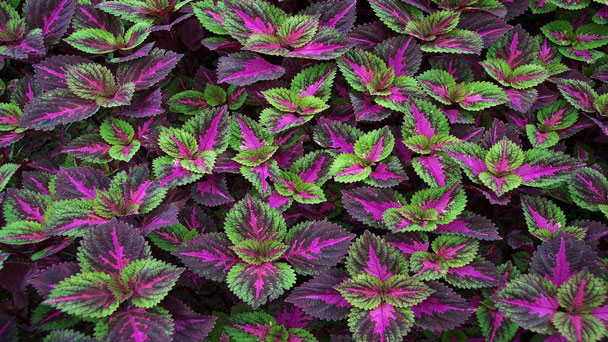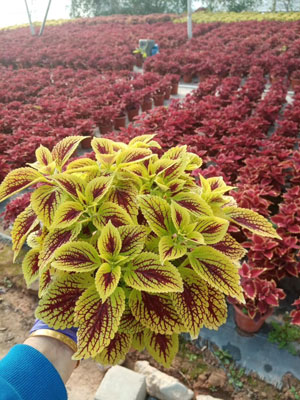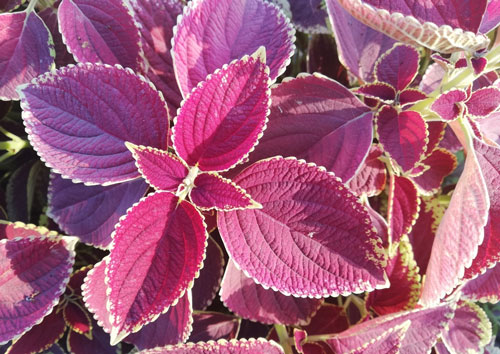Coleus (Plectranthus Scutellarioides) Grow & Care Guide
Written by Iris
Oct 13 2021

Coleus is a perennial herb, foliar flower. It is often used to arrange patterns in flower beds, conference venues, and theaters, and can also be used as a leaf for flower baskets and bouquets. Indoor furnishings are mostly small and medium-sized potted plants. Choose light-colored and smooth-textured sets of pots to set off the gorgeous leaf color of Coleus. Let’s take a look at Coleus!
Some varieties like the Wizard series are more sun-tolerant. If you have minimal shade available, pick those varieties.
The ideal temperature for these plants is between 70-100 degrees. Obviously, heat isn’t an issue! However, cold can be. If the temperature begins dipping below 50 degrees, use a cold frame to keep them warm. Alternately, bring them indoors and provide indirect light for them in a warmer location.
Plant them 30cm (12 inch) apart in rich, moist, well-drained soil preferable with a neutral or slightly alkaline pH.
These plants grow healthy in constantly damp soil, but they do not appreciate soggy conditions. Too much moisture around the roots may flatten your Coleus plant, resulting in root rot and irreversible damage. On the other hand, short periods of drought will slow down the growth and its leaves will turn brown around the edges.
For both indoor and outdoor growing, Coleus plants will respond well if you add some mulch to their planting soil. Make sure you do not use cedar mulch, as it can be very toxic to these plants. It is also worth mentioning that you shouldn’t allow the mulch to get in contact with their stems. It will promote root rot and hide pests like slugs.
They enjoy humid environments, so you can maintain the ideal levels by keeping them around other humidity-lover plants. If the air around your plant is dry, mist them regularly using a water spray. When growing in a container, you should water your Coleus once or twice a day during hot temperatures.
Keep indoor plants away from air conditioner vents and other cold spots. In dry climates, the plants will like some humidity from a humidifier or a bathroom environment. To take potted plants outdoors in spring, wait until the temperature is 70 degrees Fahrenheit or warmer.
Since this plant isn’t picky, you can usually stay away from a fertilizer schedule with it. However, if you notice a slight yellowing of the leaves, you may need to fertilize. You want to avoid over-fertilizing, since it will lead to leggy plants with weak stems and poor leaf retention. A diluted fish emulsion mixed with water can work well. Be careful—you will only want to fertilize a plant if it needs it, or the fertilizing element can burn and kill the plant from over-fertilization.
Some watering recommendation is needed, as well. You want to water the plant regularly (although not too much) and water it from the bottom, rather than from the top. Keep in mind that the leaves of the plant should be darker, rather than lighter in color.
Like most mint relatives, these can rapidly become spindly. To encourage a more bushy formation, cut or pinch off leggy stems just above a leaf node. It’s best if you choose a node that has a visible bud forming, as it will encourage the plant to fork at that location.
Wizard series: These are small 12- to 14-inch plants in standard color mixes. They are known to be very easy to grow from seeds.
Kong series: These coleus varieties have huge 6-inch leaves on big 2-foot plants. They are quite sensitive to direct sunlight.
'Black Dragon': This unusual variety has deep burgundy leaves with ruffled edges. They grow to 18 inches tall.
Premium Sun series: These cultivars are bred to tolerate full sun.
Fairway series: These are dwarf coleus varieties, only 6 to 10 inches tall, in a variety of leaf patterns and colors.
How to Grow ColeusColeus Propagation with SeedsColeus Propagation with Stem CuttingsHow to Care for ColeusColeus Lighting RequirementsColeus Soil CareColeus WateringColeus Temperature & Humidity CareColeus FertilizerColeus PruningColeus Pests & Diseases CareVarieties of ColeusColeus Care FAQIs Coleus Poisonous?Is Coleus edible?
How to Grow Coleus
Propagation of coleus is achieved both by cuttings and through seedlings.Coleus Propagation with Seeds
Seedlings can be produced in the spring and summer months by allowing some of the foliage of the plant to dry out and fall onto the ground below. These coleus plants should be covered with a sandy mulch to prevent them from drying out and dying. After a few weeks, the coleus plants will begin to produce new growth from the pieces of old plant on which the seedlings are resting, and they can be transplanted into their new growing space.Coleus Propagation with Stem Cuttings
Cuttings should be taken during the spring and summer months, with some of the best cuttings taken while temperatures are between 70° and 80°F. Cuttings are taken from the top of the plant and many times can produce up to six new plants. The cuttings should be dipped in a rooting hormone powder before they are planted into small pots of coarse sand (half sand, half potting soil). After the cuttings have been planted in their pots, they should be kept in a well-lit area and should be watered until they begin to root. One the coleus has produced new roots and there is new vegetation growing, It should be removed from the seedling pot and repotted in a slightly larger container full of potting soil and should be placed in a well-lit area until it is ready to be placed in its final growing location.How to Care for Coleus
Coleus Lighting Requirements
Although it loves warm climates, coleus light requirements are minimal. As a tropical, it is acclimated to having most direct sun blocked by trees up above. The scorching rays of the sun can bleach those gorgeous leaf colors, so try to provide at least some shade for best appearance. For the best color, provide early morning sun and afternoon shade.Some varieties like the Wizard series are more sun-tolerant. If you have minimal shade available, pick those varieties.
The ideal temperature for these plants is between 70-100 degrees. Obviously, heat isn’t an issue! However, cold can be. If the temperature begins dipping below 50 degrees, use a cold frame to keep them warm. Alternately, bring them indoors and provide indirect light for them in a warmer location.
Coleus Soil Care
Solenostemon scutellarioides prefers fertile, evenly moist, well-draining soil. It is adapted to chalk, clay, clay loam, loam, loamy sand, peat, sandy clay, sandy clay loam and sandy loam soils.Plant them 30cm (12 inch) apart in rich, moist, well-drained soil preferable with a neutral or slightly alkaline pH.
Coleus Watering
Coleus plants need more attention when it comes to watering. They have a rather fast tendency to show their owner when something is wrong with their watering routine. So, to understand their demands, all you have to do is be all-eyes and patient.These plants grow healthy in constantly damp soil, but they do not appreciate soggy conditions. Too much moisture around the roots may flatten your Coleus plant, resulting in root rot and irreversible damage. On the other hand, short periods of drought will slow down the growth and its leaves will turn brown around the edges.
For both indoor and outdoor growing, Coleus plants will respond well if you add some mulch to their planting soil. Make sure you do not use cedar mulch, as it can be very toxic to these plants. It is also worth mentioning that you shouldn’t allow the mulch to get in contact with their stems. It will promote root rot and hide pests like slugs.
They enjoy humid environments, so you can maintain the ideal levels by keeping them around other humidity-lover plants. If the air around your plant is dry, mist them regularly using a water spray. When growing in a container, you should water your Coleus once or twice a day during hot temperatures.
Coleus Temperature & Humidity Care
As a tropical plant, coleus thrives in hot, humid conditions. In temperate climates, the barest hint of frost will spell the end of the plants. Make sure to take cuttings of any favorite plants before the weather turns cold.Keep indoor plants away from air conditioner vents and other cold spots. In dry climates, the plants will like some humidity from a humidifier or a bathroom environment. To take potted plants outdoors in spring, wait until the temperature is 70 degrees Fahrenheit or warmer.
Coleus Fertilizer
The great thing about coleus is that it requires so little care and maintenance. In fact, it is often used as a houseplant because of its high tolerance for indoor conditions. plectranthus scutellarioides can grow inside complete indoor darkness and cool temperatures, if needed.Since this plant isn’t picky, you can usually stay away from a fertilizer schedule with it. However, if you notice a slight yellowing of the leaves, you may need to fertilize. You want to avoid over-fertilizing, since it will lead to leggy plants with weak stems and poor leaf retention. A diluted fish emulsion mixed with water can work well. Be careful—you will only want to fertilize a plant if it needs it, or the fertilizing element can burn and kill the plant from over-fertilization.
Some watering recommendation is needed, as well. You want to water the plant regularly (although not too much) and water it from the bottom, rather than from the top. Keep in mind that the leaves of the plant should be darker, rather than lighter in color.
Coleus Pruning
Most people love flowering plants. In this case, the leaves are much better than the flowers! When you see a coleus flower, pinch it off before it can bloom. As these are typically annuals, they can die off after flowering. Pinching the blooms off redirects the plant’s energy to leaf and plant growth instead of seed formation.Like most mint relatives, these can rapidly become spindly. To encourage a more bushy formation, cut or pinch off leggy stems just above a leaf node. It’s best if you choose a node that has a visible bud forming, as it will encourage the plant to fork at that location.
Coleus Pests & Diseases Care
Keep an eye out for mealybugs, aphids, spider mites, whitefly, blackfly & vine weevils that'll locate themselves in the cubbyholes and undersides of the leaves, with the exception of the latter in soil. Common diseases associated with Coleus are root rot, leaf-spot disease, Peronospora, botrytis, rust, powdery or downy mildew & southern blight - click here to learn more about these issues.
Varieties of Coleus
There are many dozens of coleus cultivars available with various colors, leaf textures, and patterns. Additional cultivars are developed each year, and garden centers tend to focus on a select few that have proven to be most popular among their customers. You may have to shop several different nurseries or online retailers to find the most unique varieties. Some to look for include:Wizard series: These are small 12- to 14-inch plants in standard color mixes. They are known to be very easy to grow from seeds.
Kong series: These coleus varieties have huge 6-inch leaves on big 2-foot plants. They are quite sensitive to direct sunlight.
'Black Dragon': This unusual variety has deep burgundy leaves with ruffled edges. They grow to 18 inches tall.
Premium Sun series: These cultivars are bred to tolerate full sun.
Fairway series: These are dwarf coleus varieties, only 6 to 10 inches tall, in a variety of leaf patterns and colors.

Coleus Care FAQ
Is Coleus Poisonous?
A lot of the hybrids are okay to have around both people and pets, however some varieties still have more of the "natural" qualities from the older plants. These tend to have higher levels of essential oils within the leaves, which when consumed in large quantities can cause vomiting and diarrhea.Is Coleus edible?
Though Coleus is in the mint family, it is not edible, and in fact some varieties may cause illness or stomach irritation if eaten. More importantly, though they are considered nontoxic to humans they are poisonous for dogs and cats. Signs that your pet has ingested Coleus include diarrhea and vomiting as well as loss of appetite and lethargy.Latest Updated
- Benefits of Bugleweed - 7 Science-backed Health Benefits
- Bugleweed Dangers & Side Effects - Is It Poisonous?
- How to Plant Evergreen Trees - What You Should Know
- When to Plant Evergreens - Grow Guide for Evergreen Trees
- 12 Wonderful Evergreen Shrubs for Your Garden
- 12 Popular Evergreen Plants with Pictures for Beginners
- When And How To Prune A Lilac Bush Like a Pro
- How to Grow & Care for Lilac Vine (Hardenbergia Violacea)
- Japanese Lilac Tree (Syringa Reticulata) Care & Propagation Guide
- Shumard Oak Pros and Cons - What to Know
Popular Articles
- Winter maintenance of Antirrhinum Majus
- How to Grow Terminalia Mantaly Tree
- How to Grow and Care for Crossostephium Chinense
- How to grow Antirrhinum Majus in spring
- Peristeria Elata (Dove Orchid) Profile: Info & Care Guide
- Underwatered Snake Plant (Sansevieria Trifasciata) - Signs And How To Fix
- How to Care for Brazilian Jasmine Plant (Mandevilla Sanderi)
- How to Grow & Care for Graptopetalum Purple Delight in Summer
- Rosa Chinensis (China Rose): Plant Growing & Care Tips
- How to Care for Baby Sun Rose (Aptenia Cordifolia)
